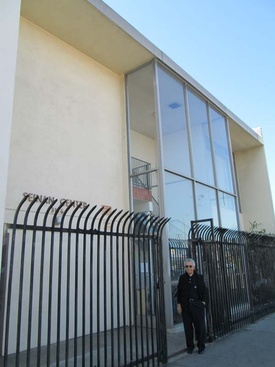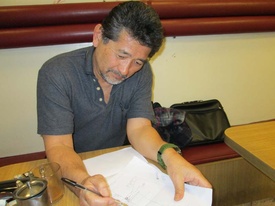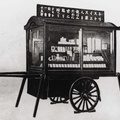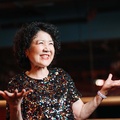Read the first part >>
Why on earth did all the Japanese people in the Southwest area disappear to where? Kunio Shiba, president of the Southwest Senior Center, answered this question.

Chairman Shiba in front of the Southwest Senior Center. "Our challenge is to pass on this center, which is a community asset, to the next generation. To that end, we are appealing to the families of our senior members to become associate members and secure this space," he said passionately.
"I think the Watts riots were a catalyst. Those riots were so violent that the whole city was wiped out. When people think of riots these days, they tend to think of the Los Angeles riots of 1992, but the Watts riots were on a completely different scale."
The Watts Riots were a series of African-American riots that continued for several days in 1965 in the city of Watts (now part of the city of Los Angeles), which is close to the Southwest. It began when a white police officer arrested an African-American man who was driving erratically. African-American residents who watched the scene suddenly erupted in anger, venting their frustrations against the police. The situation escalated to the point where the National Guard had to be called in to suppress it.
However, Shiba testifies that although the Watts Riots were one of the triggers for Japanese Americans to leave the area, they were not harmed.
"Why am I still here? Even though I experienced those riots, I wasn't harmed, so it wasn't a reason for me to leave. But the Japanese people around me moved to Orange, the South Bay, and the Valley."
Japanese and African Americans "coexist"
Yoshihiko Miyake, who moved to Seinan from Japan in 1963, two years before the Watts Riots, also talked about what it was like in the area at the time. At the age of 11, he moved to Seinan with his mother and siblings, where his father, a second-generation Japanese American, was living.
"In the 1960s, Japanese and black people naturally coexisted in the southwest. When I think back to my classmates at my local junior high school, 20% were Asian, 5% were Spanish, and the rest were black. There were no white people."
The memory of the Watts riots remains vividly burned into Miyake's mind.
"Martial law was declared, and the riots continued for about two weeks. I can still remember military vehicles driving slowly down the roads in the area, with National Guard troops at gunpoint. But the black people didn't do anything to harm us Japanese Americans. So, rather than saying that Japanese Americans began to move out of Watts, I think the reality is that as they became economically prosperous, they began to move to residential areas in the suburbs."

Miyake-san spent his youth in Seinan. "In gatherings of Japanese teens, the group from Seinan was the most senior. At the time, Seinan was the center of Japanese society," he recalls proudly. He currently lives in South Pasadena.
We then asked Miyake, who became a high school student after the Watts Riots, about his youth spent in the Southwest area.
"The place where high school students gathered was Holiday Bowl. It was a large bowling alley with 30 or 40 lanes run by Japanese Americans. If you went on the weekends it would be fully booked and there wasn't even a place to sit, and it was all Japanese people. There was also a restaurant on the premises, and their saimin was very popular as a late-night snack. At the time, people would say that the saimin in question was either the one at Atomic in Little Tokyo or the one at Holiday Bowl."
Miyake also delivered newspapers, the Rafu Shimpo and the Kashu Mainichi, by bicycle. As a part-time job in the evenings, he delivered newspapers to 200 Japanese homes in the southwest area. That's why he remembers what was around him so well. Miyake drew a map and recreated the concentration of Japanese stores over several blocks, centered around Crenshaw and Jefferson streets, from east to west and north to south.
"There was Kurata Shokai, which is now an eyeglass shop in Little Tokyo, Hakubundo, the bookstore where I bought Japanese magazines that were a month and a half behind, Kobe's, which sold stylish miscellaneous goods, my friend's family's liquor store, a Japanese-run real estate agency, a Chinese restaurant, a barber shop and a Japanese sweets shop...and the Crenshaw Dojo, the judo dojo my father ran. Judo was popular at the time, and there were dojos everywhere."
Miyake says that the number of Japanese stores started to decrease around 1968. "The dance parties that we were running started to die out, and the events in Seinan also decreased." As the generation changed from Miyake and his Japanese-oriented family to the younger generation, the town began to lose its vitality.
He moved to Japan at the age of 19, and returned to the United States seven years later, when his parents had also moved from the Southwest to Pasadena. Miyake never lived in the Southwest again.
"When I returned to the United States seven years later, I felt very lonely when I saw that there were no Japanese people left in the Southwest. I still have business at the bank, so I go to the Southwest from time to time, but I don't feel anything anymore, although I do feel nostalgic. But what makes me happy is that black people are now beautifully tending the Japanese gardens in the houses where the Japanese people used to live. I think they felt the positive influence of the Japanese people from a young age, having coexisted with them."
© 2013 Keiko Fukuda











